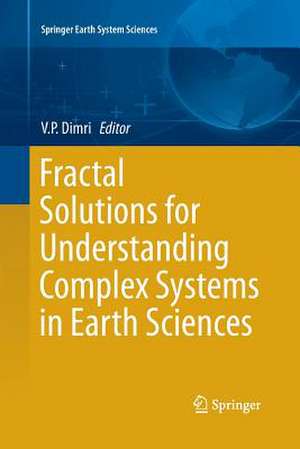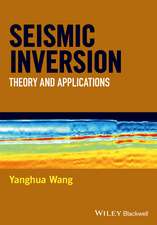Fractal Solutions for Understanding Complex Systems in Earth Sciences: Springer Earth System Sciences
Editat de V. P. Dimrien Limba Engleză Paperback – 23 aug 2016
| Toate formatele și edițiile | Preț | Express |
|---|---|---|
| Paperback (1) | 634.18 lei 6-8 săpt. | |
| Springer International Publishing – 23 aug 2016 | 634.18 lei 6-8 săpt. | |
| Hardback (1) | 640.24 lei 6-8 săpt. | |
| Springer International Publishing – 28 noi 2015 | 640.24 lei 6-8 săpt. |
Din seria Springer Earth System Sciences
- 18%
 Preț: 1023.74 lei
Preț: 1023.74 lei - 18%
 Preț: 1405.09 lei
Preț: 1405.09 lei - 18%
 Preț: 953.65 lei
Preț: 953.65 lei - 18%
 Preț: 888.18 lei
Preț: 888.18 lei - 15%
 Preț: 653.00 lei
Preț: 653.00 lei - 18%
 Preț: 1394.03 lei
Preț: 1394.03 lei - 18%
 Preț: 897.65 lei
Preț: 897.65 lei - 18%
 Preț: 997.83 lei
Preț: 997.83 lei -
 Preț: 386.22 lei
Preț: 386.22 lei - 15%
 Preț: 642.03 lei
Preț: 642.03 lei - 15%
 Preț: 639.73 lei
Preț: 639.73 lei - 24%
 Preț: 804.32 lei
Preț: 804.32 lei - 15%
 Preț: 642.51 lei
Preț: 642.51 lei - 15%
 Preț: 640.24 lei
Preț: 640.24 lei - 18%
 Preț: 1244.89 lei
Preț: 1244.89 lei - 15%
 Preț: 646.30 lei
Preț: 646.30 lei - 20%
 Preț: 586.47 lei
Preț: 586.47 lei - 18%
 Preț: 733.46 lei
Preț: 733.46 lei - 18%
 Preț: 1229.73 lei
Preț: 1229.73 lei - 15%
 Preț: 641.53 lei
Preț: 641.53 lei - 20%
 Preț: 578.60 lei
Preț: 578.60 lei - 24%
 Preț: 819.28 lei
Preț: 819.28 lei -
 Preț: 374.37 lei
Preț: 374.37 lei - 24%
 Preț: 680.55 lei
Preț: 680.55 lei - 20%
 Preț: 576.85 lei
Preț: 576.85 lei - 18%
 Preț: 973.56 lei
Preț: 973.56 lei - 24%
 Preț: 829.71 lei
Preț: 829.71 lei - 15%
 Preț: 639.73 lei
Preț: 639.73 lei - 15%
 Preț: 639.90 lei
Preț: 639.90 lei - 15%
 Preț: 695.85 lei
Preț: 695.85 lei - 18%
 Preț: 948.92 lei
Preț: 948.92 lei - 18%
 Preț: 958.38 lei
Preț: 958.38 lei - 24%
 Preț: 789.36 lei
Preț: 789.36 lei - 18%
 Preț: 956.99 lei
Preț: 956.99 lei - 24%
 Preț: 799.20 lei
Preț: 799.20 lei - 20%
 Preț: 569.00 lei
Preț: 569.00 lei - 15%
 Preț: 637.28 lei
Preț: 637.28 lei - 15%
 Preț: 634.82 lei
Preț: 634.82 lei -
 Preț: 408.86 lei
Preț: 408.86 lei
Preț: 634.18 lei
Preț vechi: 746.09 lei
-15% Nou
Puncte Express: 951
Preț estimativ în valută:
121.35€ • 126.70$ • 100.43£
121.35€ • 126.70$ • 100.43£
Carte tipărită la comandă
Livrare economică 04-18 aprilie
Preluare comenzi: 021 569.72.76
Specificații
ISBN-13: 9783319370781
ISBN-10: 3319370782
Pagini: 152
Ilustrații: XIII, 152 p. 74 illus.
Dimensiuni: 155 x 235 mm
Greutate: 0.25 kg
Ediția:Softcover reprint of the original 1st ed. 2016
Editura: Springer International Publishing
Colecția Springer
Seria Springer Earth System Sciences
Locul publicării:Cham, Switzerland
ISBN-10: 3319370782
Pagini: 152
Ilustrații: XIII, 152 p. 74 illus.
Dimensiuni: 155 x 235 mm
Greutate: 0.25 kg
Ediția:Softcover reprint of the original 1st ed. 2016
Editura: Springer International Publishing
Colecția Springer
Seria Springer Earth System Sciences
Locul publicării:Cham, Switzerland
Cuprins
Introduction.- Scaling Laws in Geophysics: Application to Potential Fields of Methods Based on the Laws of Self-Similarity and Homeogeneity.- Curie Depth Estimation from Aeromagnetic for Fractal Distribution of Sources.- Fractal Faults: Implications in Seismic Interpretation and Geomodeling Detrended Fluctuation Analysis of Geophysical Well-Log Data.- Application of Fractal Geometry to Explain Fluid Flow through Subsurface Fractures.- Estimation and Application of Fractal Differential Adjacency Segregation (F-DAS) Scores in Analysis of Scanning Electron Micro Graph (SEM) Imageries towards Understanding the Adsorption unto Porous Solids.- The Multi-Fractal Scaling Behaviour of Seismograms based on the Detrended Fluctuation Analysis.- Fractal Methods in the Investigation of the Time Dynamics of Fires: A Review.
Textul de pe ultima copertă
This book deals with fractals in understanding problems encountered in earth science, and their solutions. It starts with an analysis of two classes of methods (homogeneous fractals random models, and homogeneous source distributions or “one point” distributions) widely diffused in the geophysical community, especially for studying potential fields and their related source distributions. Subsequently, the use of fractals in potential fields is described by scaling spectral methods for estimation of curie depth. The book also presents an update of the use of the fractal concepts in geological understanding of faults and their significance in geological modelling of hydrocarbon reservoirs. Geophysical well log data provide a unique description of the subsurface lithology; here, the Detrended Fluctuation Analysis technique is presented in case studies located off the west-coast of India. Another important topic is the fractal model of continuum percolation which quantitatively reproduce the flow path geometry by applying the Poiseuille’s equation. The pattern of fracture heterogeneity in reservoir scale of natural geological formations can be viewed as spatially distributed self-similar tree structures; here, the authors present simple analytical models based on the medium structural characteristics to explain the flow in natural fractures. The Fractal Differential Adjacent Segregation (F-DAS) is an unconventional approach for fractal dimension estimation using a box count method. The present analysis provides a better understanding of variability of the system (adsorbents – adsorbate interactions). Towards the end of book, the authors discuss multi-fractal scaling properties of seismograms in order to quantify the complexity associated with high-frequency seismic signals. Finally, the book presents a review on fractal methods applied to fire point processes and satellite time-continuous signals that are sensitive to fire occurrences.
Caracteristici
Comprehensive set of reviews on geophysical tools dealing with fractals Application oriented methods related to oil prospecting Presents new solutions to a variety of geophysical topics such as rheology and remote-sensing Includes supplementary material: sn.pub/extras









